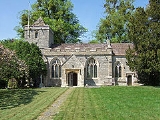
Church of All Saints, Alford
Encyclopedia
The Church of All Saints which is next to the River Brue
in Alford
, Somerset
, England dates from the 15th century, with minor 19th-century restoration
. It has been designated as a Grade I listed building.
The church has a 2-bay chancel
and 3-bay nave
and a south porch. The 2-stage tower, which is at the west end of the church contains a bell dating from 1753 and made by Thomas Bilbie of the Bilbie family
.
The fittings include a Jacobean
pulpit, dated 1625, and 16th-century benchends. The north windows have medieval stained glass
including a large figure of Mary Magdalene
.
The parish is part of the Six Pilgrims Benefice, which also includes Babcary
, Hornblotton, Lovington
, North Barrow
and South Barrow
and is part of Wells
Archdeanery.
River Brue
The River Brue originates in the parish of Brewham in Somerset, England, and reaches the sea some 50 km west at Burnham-on-Sea. It originally took a different route from Glastonbury to the sea, but this was changed by the monastery in the twelfth century....
in Alford
Alford, Somerset
Alford is a village and parish on the River Alham, in Somerset, England, situated south of Shepton Mallet and two miles west of Castle Cary in the South Somerset district. The village has a population of 63. It lies on the River Cary.-History:...
, Somerset
Somerset
The ceremonial and non-metropolitan county of Somerset in South West England borders Bristol and Gloucestershire to the north, Wiltshire to the east, Dorset to the south-east, and Devon to the south-west. It is partly bounded to the north and west by the Bristol Channel and the estuary of the...
, England dates from the 15th century, with minor 19th-century restoration
Victorian restoration
Victorian restoration is the term commonly used to refer to the widespread and extensive refurbishment and rebuilding of Church of England churches and cathedrals that took place in England and Wales during the 19th-century reign of Queen Victoria...
. It has been designated as a Grade I listed building.
The church has a 2-bay chancel
Chancel
In church architecture, the chancel is the space around the altar in the sanctuary at the liturgical east end of a traditional Christian church building...
and 3-bay nave
Nave
In Romanesque and Gothic Christian abbey, cathedral basilica and church architecture, the nave is the central approach to the high altar, the main body of the church. "Nave" was probably suggested by the keel shape of its vaulting...
and a south porch. The 2-stage tower, which is at the west end of the church contains a bell dating from 1753 and made by Thomas Bilbie of the Bilbie family
Bilbie family
The Bilbie family were bell founders and clockmakers based initially in Chew Stoke, Somerset and later at Cullompton, Devon in south-west England from the late 17th century to the early 19th century....
.
The fittings include a Jacobean
Jacobean architecture
The Jacobean style is the second phase of Renaissance architecture in England, following the Elizabethan style. It is named after King James I of England, with whose reign it is associated.-Characteristics:...
pulpit, dated 1625, and 16th-century benchends. The north windows have medieval stained glass
Stained glass
The term stained glass can refer to coloured glass as a material or to works produced from it. Throughout its thousand-year history, the term has been applied almost exclusively to the windows of churches and other significant buildings...
including a large figure of Mary Magdalene
Mary Magdalene
Mary Magdalene was one of Jesus' most celebrated disciples, and the most important woman disciple in the movement of Jesus. Jesus cleansed her of "seven demons", conventionally interpreted as referring to complex illnesses...
.
The parish is part of the Six Pilgrims Benefice, which also includes Babcary
Babcary
Babcary is a village and parish in Somerset, England, situated east of Somerton and south west of Castle Cary in the South Somerset district. The village has a population of 239. It lies close to the River Cary and the A37.-History:...
, Hornblotton, Lovington
Lovington, Somerset
Lovington is a village and civil parish in Somerset, England, situated south west of Castle Cary, between the River Brue and River Cary, in the South Somerset district...
, North Barrow
North Barrow
North Barrow is a village and civil parish to the north-east of Ilchester in the South Somerset district of Somerset, England.-History:The parish was part of the hundred of Catsash.-Governance:...
and South Barrow
South Barrow
South Barrow is a village and civil parish approximately north of Sparkford and north-east of Ilchester in the South Somerset district of Somerset, England.-History:...
and is part of Wells
Wells
Wells is a cathedral city and civil parish in the Mendip district of Somerset, England, on the southern edge of the Mendip Hills. Although the population recorded in the 2001 census is 10,406, it has had city status since 1205...
Archdeanery.

